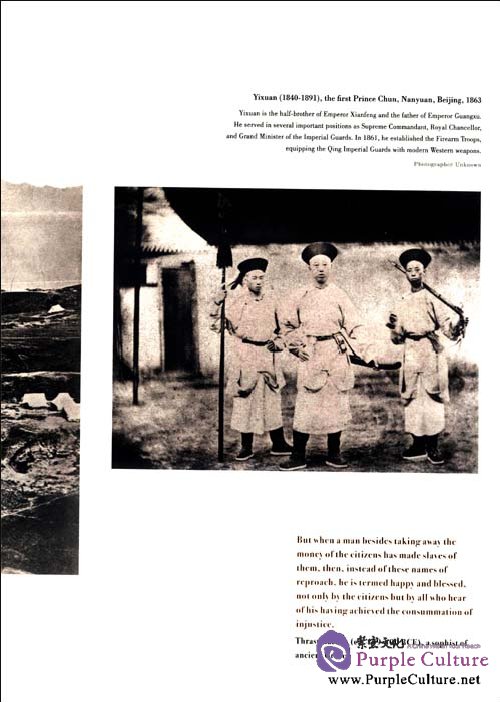Details
The 1911 Revolution ended dynastic rule in China and paved the way for
the founding of Asia's first republic Triggered by an accidental bomb
explosion in Wuchang (modern-dayWuhan), the revolution marked the
culminatingpoint of decades of internal rebellion, foreignaggression and
political decline; its leaders drewon a ferment of reformist and
revolutionary ideasproduced by some of China's greatest modernthinkers.
Although the 1911 Revolution did notresolve China's problems,it changed
the countryfor ever, clearing a path for modernization, andmaking
possible the more decisive revolutionof1949.
From the Opium War to
the. Warlord Eraassembles a remarkable survey of historicalphotographs
from leading collections around theworld.The images stretch from the
Second OpiumWar to the Sino-Japanese War of 1894-1895, fromthe Boxer
Rebellion to the Russo-Japanese Warand the outbreak of revolution
through the riseand fall ofYuan Shikai an the ensuingWarlord Era.
Accompanying
an introductory essay bythe editor Liu Heung Shing are essays fromthree
scholars of revolutionary China - JosephI/sherick of UC San Diego, Max
K.W. Huang ofthe "Academia Sinica", and Zhang Haipeng of theChinese
Academy of Social Sciences reflectingon the causes, achievements and
failures of the 1911 Revolution, and its enduring meaning.
This book
is simply superb. Liu Heung Shing travelledthe world to secure the rare
collection of photographsthat present the last 100 years of China's
tumultuoushistory in the most vivid, searing light yet achieved in
asingle volume.James Kynge, author of China Shakes the World6iChina's
tumultuous encounter with the West over a century is captured in this
remarkablecollection of photographs. Combing arcluves around the world,
Liu has unearthed imagesat once poignant and provocative, of mandarins
and schoolboys, officers and ear-cleanersinhabiting a country on the
cusp of modernity.From the Opium War to the Warlord Era is aunique
visual history of an era that continues to shape Clunese sensibilities
today."Petcr Hcsslcr. author of'Rrver Tou,n: Two Years on the Yungtze.
About Author
Liu Heung Shing is a former foreign correspondent and photojournalist whose postings
took him from Beijing to Uos Angeles, New Delhi to Seoul, and to Moscow
for the Associated Press. During that time he photographed major world
events fromtlic Soviet military occupation of A fghanistan toeivil war
in Sri Lanka and China's)urgeoningeconomic reforms.
He was also on
hand to capture the fall of the USSR: in 1992,IJiu shared a Pulitzer
Prize for Spot News and an Overseas Press Club A ward for his covcrage
of the Soviet Union's collapse. In1989,Liu was honored with the award of
Pictureof the Ycar by the School of Journalism at the Unit-rsity of
Missouri in the same year, Liu wasnamed Best Photographer by the
Associated Press Mannaging Editors.
Liu is the author of the widely
acclaimed Photographic documentation China After Mao and Soviet Union:
Collapse of an Empire. He is the editor of China. Portrait of a Country,
which has been published in six languages The book was selected by
Britain's Sunday rimes as the Best Pic-turc Book 2008.
In 2010,liu
co-authored with Karen Smith Shanghai: A Uistory in Photographs,
1842-Today. In 2004. Paris Photo named Liu as one of thehundrcd most
influential people in contemporarypho to graphy.
Liu graduatcd from Ilunter College, City Lniversity of Neu Vork in 1975.He lives and Works in Beijing.
Table of Contents
THE TUMULTUOUS ROAD
TO 1911: A VISUAL
HISTORY
1911: FROM MANCHU
RULE TO A CENTURY OF
REVOLUTION
WIIY THE 1911
REVOLUTION SUCCEEDED
REVOLUTION AND
REPUBLIC: THE IDEAS
WHICH FUELED THE 1911
REVOLUTION
THE SECOND OPIUM WAR
1894-1895
THE SINO-JAPANESE WAR
1898-1903
THE BOXER
REBELLION
1904-1905
THE RUSSO-JAPANESE WAR
1911
THE WUCHANG
UPRISING
1912 -1928
THE CHINESE
WARLORD ERA
TIMELINE
ACKNOWLEDGEMENT
INDEX OF
PHOTOGRAPHERS
BIBLIOGRAPHY
NOTES
Sample Pages Preview



